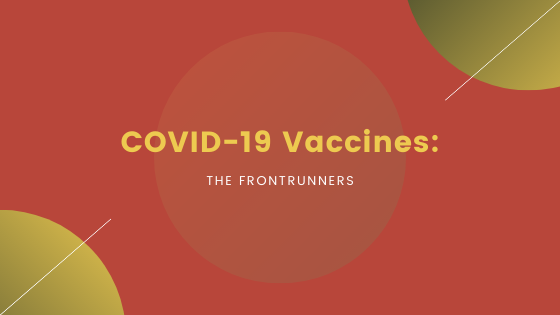We’re delighted to bring you a guest post from Sheeva Azma of Fancy Comma, LLC, and Nidhi Parekh of The Shared Microscope, all about the one thing everyone is waiting for, a COVID-19 vaccine!
The two frontrunners in the race to a COVID-19 vaccine are the Moderna vaccine and the Oxford/AstraZeneca vaccine. Read on to learn more about each of these vaccines, which both will begin the last stage of clinical trials before FDA approval in the next few months.
SARS-CoV-2 is the Virus That Causes COVID-19
Before we get into the science behind these vaccines, let’s first note a few things about the structure of SARS-CoV-2, the novel coronavirus that causes COVID-19. The structure of the virus has some unique properties that are being exploited in COVID-19 vaccine development. By now, you have surely seen this iconic visualization of the pandemic virus, SARS-CoV-2:

See those red protrusions on the surface of the virus molecule? These are called spike proteins that help the virus enter our cells and allow SARS-CoV-2 to replicate inside them. The ability of the spike proteins to allow the virus to enter your cells is what causes a COVID-19 infection. The current thinking in COVID-19 vaccines is that, if the spike proteins can be somehow disabled, the virus won’t be able to get into our cells, thereby preventing COVID-19 infection.
The Moderna Vaccine
How was this vaccine invented?
The Moderna vaccine is the fastest ever vaccine currently under development! The vaccine took 42 days to develop, going from genetic sequence analysis in silico, to human clinical trials. Check out the timeline for the Moderna vaccine.
How does it work?
The Moderna vaccine was developed based on the messenger RNA (mRNA) of SARS-COV-2. The vaccine contains the instructions for our bodies to produce the spike protein. Using these instructions, our bodies develop antibodies to the spike protein. The antibodies prevent future infection by SARS-CoV-2 by neutralising the virus. Once a SARS-CoV-2 virus enters the body of someone immunized with the Moderna vaccine, their immune system will attack the spike proteins on the virus and work to quickly neutralize the virus before it can spread and infect more cells.
Fancy Comma and The Shared Microscope have teamed up to write a detailed post about how the Moderna vaccine works.
When will it be available?
Phase 3 clinical trials are the last step in the clinical trial process before FDA approval. Phase 3 trials for Moderna are slated to start sometime in July. Moderna also recently signed an agreement with biotechnology supplier Catalent to enable large-scale distribution of the vaccine once it is approved.

The Oxford/AstraZeneca Vaccine
How was this vaccine invented?
The Oxford/AstraZeneca vaccine was developed in the Jenner Institute at Oxford University. Initially, researchers were working on a vaccine for a related coronavirus, a virus called MERS-CoV that causes the Middle East Respiratory Syndrome. However, when the COVID-19 pandemic started, the researchers shifted their efforts. They took advantage of their work studying the spike protein in MERS to create a similar vaccine for the spike proteins in the novel coronavirus. AstraZeneca partnered with Oxford to help accelerate distribution efforts pending successful completion of Phase 3 clinical trials and FDA approval.
Want to learn more about how some of the COVID-19 treatments work? Find out more here!
How does it work?
The Oxford/AstraZeneca vaccine uses a viral vector to help us develop immunity to SARS-CoV-2. A viral vector vaccine is essentially a mashup of different viruses with their genes altered so that they can have different functions. The alteration also ensures that the viruses cannot cause infection in the person to whom the vaccine is administered. In the case of this vaccine, the viral vector includes a virus called ChAdOx1 as its base, to which the genetic material for the SARS-CoV-2 spike protein is added. The result is a viral vector that has been genetically altered to not be contagious, but that contains the genetic material for the spike protein, so that the body can learn about it and develop immunity to the spike proteins.
Fancy Comma, along with The Shared Microscope, have written a detailed post on the Oxford/Astrazeneca vaccine. Check out our detailed blog post on the Fancy Comma blog to learn more about how the Oxford/AstraZeneca vaccine works.
When will it be available?
Oxford/AstraZeneca has already begun simultaneous Phase 2/3 clinical trials. If all goes according to plan, the vaccine would be available for use in Fall 2020.
Will we definitely have a COVID-19 vaccine this year?
For vaccines to be accepted for release into the population, they must pass tests demonstrating their safety and effectiveness. This is why we conduct trials on select individuals – to prevent endangering the vulnerable.
Currently, there is no guarantee that either the Moderna vaccine or the Oxford/AstraZeneca vaccine will pass these tests. It should be noted that a significant proportion of vaccines tested in clinical trials do not pass all safety and efficacy tests. If this is the case, and manufacturers are unable to show that the vaccine is protective against COVID-19, alternative approaches need to be examined, such as changing the dosage, trying another vector, etc. If there is evidence that the alternates don’t work/are not safe, the entire study will be scrapped.
We are often asked why there are so many vaccines under development. This is because, although they are farthest in the race, they are not guaranteed to ‘complete’ it, so to speak. They will not be allowed to unless it is scientifically proven that what they have made is safe and effective for use in almost anyone. The race, therefore, is ongoing, and may continue until we have more information.
For information on other COVID-19 vaccines in development, keep an eye on the Fancy Comma and The Shared Microscope sites as they are doing a major rundown of some of the front runners in the race against COVID-19!
About the authors:

Nidhi Parekh blogs at The Shared Microscope. Check out The Shared Microscope on Twitter, Facebook, and Instagram for informative, effective illustrations of concepts in biology.

Sheeva Azma is a founder and lead writer/researcher at science writing company Fancy Comma, LLC, which can be found on LinkedIn, Facebook, Twitter, and Instagram.




